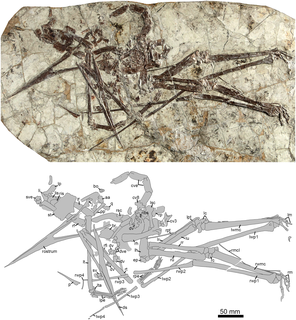Tapejara may refer to:
- Tapejara wellnhoferi , a species of pterosaur
- Tapejara, Rio Grande do Sul
- Tapejara, Paraná
Tapejara may refer to:

Tapejara is a genus of Brazilian pterosaur from the Cretaceous Period. Tapejara crests consisted of a semicircular crest over the snout, and a bony prong which extended back behind the head.

The Aptian is an age in the geologic timescale or a stage in the stratigraphic column. It is a subdivision of the Early or Lower Cretaceous epoch or series and encompasses the time from 125.0 ± 1.0 Ma to 113.0 ± 1.0 Ma, approximately. The Aptian succeeds the Barremian and precedes the Albian, all part of the Lower/Early Cretaceous.

Tapejaridae are a family of pterodactyloid pterosaurs from the Cretaceous period. Members are currently known from Brazil, England, Hungary, Morocco, Spain and China, where the most primitive genera are found, indicating that the family has an Asian origin.

Bakonydraco is a genus of pterodactyloid pterosaur from the Late Cretaceous period of what is now the Csehbánya Formation of the Bakony Mountains, Iharkút, Veszprém, western Hungary.
Eopteranodon is a genus of tapejarid pterosaur from the Aptian-age Lower Cretaceous Yixian Formation of Beipaio City, Liaoning, China. The genus was named in 2005 by paleontologists Lü Junchang and Zhang Xingliao. The type and only species is Eopteranodon lii.

Azhdarchoidea is a group of pterosaurs within the suborder Pterodactyloidea, more specifically within the group Ornithocheiroidea. Pterosaurs belonging to this group lived throughout the Early and Late Cretaceous periods, with one tentative member, Tendaguripterus, that lived in the Late Jurassic period. The largest azhdarchoids include members of the family Azhdarchidae, examples of these are Quetzalcoatlus, Hatzegopteryx, and Arambourgiania. The Azhdarchoidea has been recovered as either closely related to the Ctenochasmatoidea, as the sister taxon of the Pteranodontoidea within the Ornithocheiroidea, or within the Tapejaroidea, which in turn was also within the Ornithocheiroidea.

Tupandactylus is a genus of tapejarid pterodactyloid pterosaur from the Early Cretaceous Crato Formation of Brazil. It is notable for its large cranial crest, composed partly of bone and partly of soft tissue. The genus Tupandactylus possibly contains two species, both bearing differently sized/shaped crests that may have been used to signal and display for other Tupandactylus, much as toucans use their bright bills to signal to one another. Tupandactylus crests consisted of a semicircular crest over the snout, and in the case of the type species T. imperator, a bony prong which extended back behind the head. A second species, T. navigans, lacked this prong, and had a much more vertical crest. Soft tissue impressions also show that the small bony crests were extended by a much larger structure made of a keratinous material. The complete crest of T. navigans rose in a sharp, sail-like "dome" high above the rest of the skull.

Ciríaco is a municipality in the state of Rio Grande do Sul, Brazil. As of 2020, the estimated population was 4,719.

Tapejara is a municipality in the state of Rio Grande do Sul, Brazil. As of 2020, the estimated population was 24,552.
Neutral point of view may refer to:
Xtractaurs is a line of toys by Mattel. Introduced in 2009, the brand is a fusion of regular action figures with an online game. It involves taking a dinosaur and extracting "DNA" samples from the dinosaur and analyzing it on your computer, similar in a way to the book and film Jurassic Park. If you own multiple dinosaurs and have extracted samples from all of them, you can create a genetically engineered hybrid on the computer to battle the "Megavores", ancient reawakened dinosaurs that share qualities with your dinosaur. Each dinosaur you purchase has a special ability, and combining them makes a fierce fighting animal. This encourages the fusion of certain samples even more.

Tapejara, Paraná is a municipality in the state of Paraná in the Southern Region of Brazil.

Chaoyangopteridae is a family of pterosaurs within the larger group Azhdarchoidea.
Flying Monsters 3D is a natural history documentary about the pterosaurs. It was written and presented by David Attenborough and was produced by National Geographic and Atlantic Productions for Sky 3D. Originally broadcast on Christmas Day 2010, it was the first 3D documentary to be screened on British television and was released in theatres and IMAX cinemas the following year. Flying Monsters 3D went on to become the first 3D programme to win a BAFTA award.

Europejara is a genus of tapejarid pterosaur from the Early Cretaceous period of Spain. The type and only species known is Europejara olcadesorum.

Vectidraco, is a genus of azhdarchoid pterosaur from the Lower Cretaceous of England.

Caiuajara is an extinct genus of tapejarid pterosaur from the Late Cretaceous period of Brazil. It is known from a single type species, Caiuajara dobruskii.

Tapejaroidea is a group of pterosaurs belonging to the clade Ornithocheiroidea. Tapejaroids lived from the Early to Late Cretaceous periods, with one possible member, Tendaguripterus, extending the fossil range to the Late Jurassic period. Tapejaroidea also contains some of the largest-known animals to ever fly, as it includes the clade Azhdarchoidea. The group was named by Brazilian paleontologist Alexander Kellner in 1996. Tapejaroidea is subdivided into two smaller groups: the family Dsungaripteridae and the clade Azhdarchoidea.

Tapejaromorpha is a group of pterosaurs within the suborder Pterodactyloidea.

Afrotapejara is an extinct genus of tapejarid pterosaur discovered in Morocco. The type species, Afrotapejara zouhri, was named and described in 2020. It was the first tapejarid discovered in Africa and the fourth pterosaur discovered in the Kem Kem Beds.